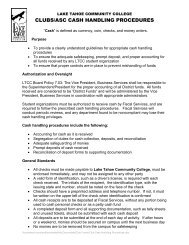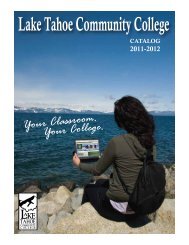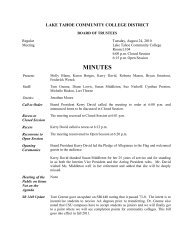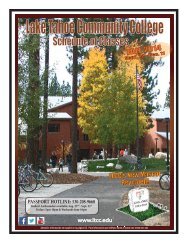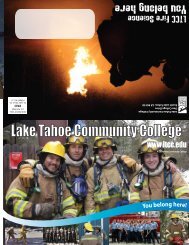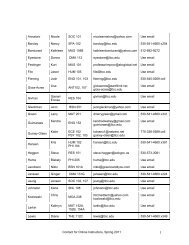View the 2010-2011 Catalog (4 MB) - Lake Tahoe Community College
View the 2010-2011 Catalog (4 MB) - Lake Tahoe Community College
View the 2010-2011 Catalog (4 MB) - Lake Tahoe Community College
- No tags were found...
Create successful ePaper yourself
Turn your PDF publications into a flip-book with our unique Google optimized e-Paper software.
LTCC CATALOG <strong>2010</strong>-<strong>2011</strong> 59 MAJORSArtThe Visual Arts program is designed to provide a balanced foundation 5. Minimum of 12 total units from any four of <strong>the</strong> five areas:in both studio art and art history. Its curriculum is focused to meeta. ART 210 Watercolor Painting<strong>the</strong> needs of art students who are initially developing skill and concepts aswell as those experienced students who seek fur<strong>the</strong>r development. The artdepartment is committed to a structured environment in which facultyand students work closely toge<strong>the</strong>r in an atmosphere which is responsive,supportive, and facilitates experimentation.ART 211ART 212ART 234ART 240b. ART 221Painting IPainting IIFigure PaintingPainting: Narrative and SymbolismPrintmakingc. ART 201 Beginning SculptureART 217 Sculpture: Modeling and CastingART 218 Sculpture: Modeling and CarvingART 219 Sculpture: MetalsART 220 Figure SculptureART 236 Beginning Bronze CastingART 237 Intermediate Bronze CastingART 238 Advanced Bronze Castingd. ART 146 Digital Photography IART 148 Digital Photography IIART 244 Color PhotographyART 247 Portrait PhotographyART 248 Commercial PhotographyART 249 Art Concepts for Graphic DesignStudent Learning Outcomes for this major are:• Explain <strong>the</strong> history of Western art and itscultural significance and <strong>the</strong> role that art has had in shaping our livesand aes<strong>the</strong>tics.• Demonstrate practical knowledge of how to develop an artist’sportfolio and conduct business as a professional artist.• Apply <strong>the</strong> basic principles of observational drawingand how to develop illusionary spatial constructions.• Apply knowledge of human anatomy in <strong>the</strong>construction of figurative works of art.• Apply <strong>the</strong> principles and concepts of design;• Demonstrate knowledge of <strong>the</strong> science of color perception and how itcan be utilized in <strong>the</strong> creation of works of art.• Have a knowledge of art materials and an applied experience in <strong>the</strong>technical means used to formulate and construct visual images.•••A. GENERAL EDUCATION REQUIREMENTS(See page 45 for details).B. REQUIRED COURSES41.5 units distributed as follows:1. All courses from <strong>the</strong> following:ART 101 Art History: Prehistoric - IslamicART 102 Art History: Medieval Europe - RenaissanceART 103 Art History: Baroque - ContemporaryART 118 ColorART 122 Art Exhibit ProductionART 228 Developing a Portfolio2. 6 units from:ART 114 Beginning Drawing from ObservationART 115 Drawing: Wet MediaART 116 Drawing: Concept and ImageART 117 Landscape DrawingART 214 Advanced Drawing from ObservationART 215 Advanced Drawing: Wet MediaART 216 Advanced Drawing: Concept and ImageART 224 Portraiture3. 3 units from:ART 111 Two-Dimensional DesignART 112 Two- and Three-Dimensional DesignART 113 Three-Dimensional Design4. 3 units from:ART 213 Beginning Life DrawingART 223 Intermediate Life DrawingART 233 Advanced Life Drawinge. ART 120 Intermediate CeramicsART 239 Advanced CeramicsC. ELECTIVE UNITS to bring <strong>the</strong> total to 90.




